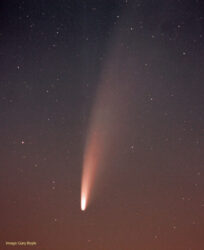Comet Neowise pays a visit
By Submitted Article on July 15, 2020.
 Comet Neowise is passing by the Earth this month, close enough to be visible to the naked eye. Photo by Gary Boyle
Comet Neowise is passing by the Earth this month, close enough to be visible to the naked eye. Photo by Gary BoyleGary Boyle
THE BACKYARD ASTRONOMER
A bright comet is now in the evening sky and you can see it without a telescope. Comet F3 (Neowise) has been a fantastic object in the early morning pre-dawn sky but will be well placed below the Big Dipper to see and photograph over the next couple of weeks and hopefully into August. I have been following and imaging this comet since the first week of July and could see it even without binoculars (naked eye).
The comet was discovered on March 27 by the Neowise space telescope as it looks for near-earth objects that could potentially impact our planet. Measuring a little more than half the height of Mount Everest, this object falls into the category of a “once in a decade” comet.
Every year astronomers both amateur and professional observe five to 10 comets with telescopes. In most cases, they show a green nucleus from the sublimation of frozen chemicals such as ammonia and others. The extremely faint tail is seen when photographed but all comets are different in composition and appearance as Neowise does not appear green. The last bright comet that was visible to the naked eye for the whole world to see was Comet Hale-Bopp in 1997. And like Neowise, it, too, had a blue ion or gas tail and a fan-shaped dust tail created when comets round the sun as this one did on July 3 at a close distance of 43 million kilometres.
Neowise will be closest to earth on its way out of the solar system on July 22 at a safe distance of 103 million kilometres and will be starting to fade with a shortening tail as it retreats from the sun’s heat and back to the icy depths of space. Comet Neowise originates from the Oort Cloud, where long-period comets reside and will return close to 6,800 years from now.
Halley’s Comet is a short-period comet originating from the Kuiper Belt. Along with this chart of the comet’s path, many smartphone astronomy apps will also guide you to our celestial visitor. Enjoy this spectacular comet every chance you can as you never know when the next bright one will come to visit.
Known as “The Backyard Astronomer,” Gary Boyle is an astronomy educator, guest speaker >and columnist for the Royal Astronomical Society of Canada. He has been interviewed on more than 50 Canadian radio stations and local Ottawa TV. In recognition of his public outreach in astronomy, the International Astronomical Union has honoured him with the naming of Asteroid (22406) Garyboyle. Follow him on Twitter: @astroeducator or his website: http://www.wondersofastronomy.com.
9-8




